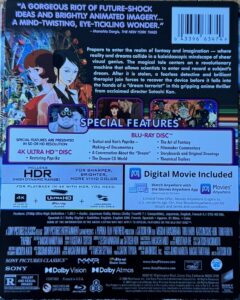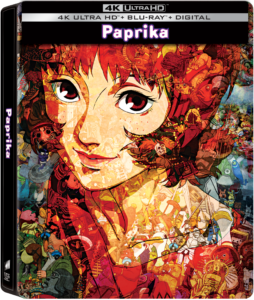 The 2006 anime Paprika comes from writer/director Satoshi Kon (Satoshi Kon), and the screenplay is based on the acclaimed 1993 novel of the same name by author Yasutaka Tsutsui.
The 2006 anime Paprika comes from writer/director Satoshi Kon (Satoshi Kon), and the screenplay is based on the acclaimed 1993 novel of the same name by author Yasutaka Tsutsui.
The film is set in Japan, in the near future. Scientist Tokita Kohsaku (Tôru Furuya) is a big kid trapped inside the body of a (really) large genius. He has invented a device called the “DC Mini”, which allows its wearer to view and record another person’s dreams. Tokita’s colleague, Dr. Chiba Atsuko (Megumi Hayashibara), has been taking one of the prototype devices outside of the research facility to aid in the psychoanalysis of her patients. She hopes to be able to treat people’s illnesses by looking at their dreams. Atsuko has been trying to help police Detective Kogawa Toshimi (Akio Ôtsuka), who has been having a recurring nightmare that finds him first attacked by a crowd in a circus tent, then making his way through various film genres, and ending up in a stark hotel hallway looking at a dead body. This dream seems to be related to an open homicide case he’s been trying to solve for years.
One evening, when Atsuko returns to her office, she learns that one of the DC Minis has been stolen. Since it was just a prototype, its access was never programmed to be restrictive, which means whomever stole it will be able to tap into anyone’s mind and mess with their dreams. Just then, Atsuko’s boss, Doctor Shima Tora-taroh (Katsunosuke Hori) walks in the room, speaking gibberish. Someone has implanted another patient’s dream into his head, and now he thinks he’s part of a huge parade of random objects, which causes him to throw himself out the window and nearly get killed. The company’s chairman, Doctor Inui Sei-jiroh (Tôru Emori), is extremely upset—he never approved of the project in the first place, and now forbids any more use of the DC Minis. Atsuko tries to assure him that the device is an invaluable tool for psychoanalysis, but it’s already too late. Soon more scientists start displaying odd behavior. So Atsuko enters the dream world as her spritely alter-ego Paprika, to investigate, figure out who is behind this, and try to stop them. However, the longer it takes, the more the dream world and reality start to fuse, and it gets more and more difficult to tell which is which. Can Paprika save the day before it’s too late and everyone starts experiencing the same waking dream-turned-nightmare?
One can’t help but notice some similarities between Paprika and Christopher Nolan’s 2010 film Inception, which also involves implanting things in other’s mind and dreams and reality clashing. While there are some conspiracy theorists who believe that Nolan stole a lot of his ideas from this book/movie, it’s more likely to just be a coincidence.
I’ll start off by saying that Paprika is a visually stunning film, with some very odd and creative imagery. It sometimes feels like the filmmakers were on some sort of acid trip or experiencing a fever dream when they came up with this stuff. Anything seems possible in this dream world, and people and objects are constantly transforming and changing. Paprika and the others never know what they are looking for as characters take on the forms of dolls, robots, and more. The dream world is filled with bright, explosive color, and an oddly catchy techno soundtrack. When Atsuko enters the dream world as Paprika, she can become anything, from a butterfly, to a mermaid, to the Monkey King, or anything else her mind can come up with. She is determined to find the person who is responsible for this crazy shared dream, and uses her smarts and skills to help stop it.
That said, I would be lying if I said that I actually understood everything that was going on in this film. This is a very complex and confusing story at times, especially as reality and the dream world collide—the characters find themselves in some sort of shared dream state, where even Paprika and Atsuko can co-exist together. I was surprised while watching the bonus features when the author of the original novel applauded the writer/director of the film for making his version less complex—if that’s the case, then I can’t imagine what happens in the book! However, the imagery and creativeness of the animation is enough to keep the viewer interested even if they don’t always understand what’s happening.
Sony had previously released Paprika on Blu-ray back in 2007, but this new 4K SteelBook release is the first time the film has gotten the 4K treatment. In a new 8-minute featurette, the filmmakers discuss the process they went through to remaster the picture and sound. The results of which are quite stunning. The film still looks very much hand-drawn, with softer lines, but colors are now brighter and richer thanks to the new Dolby Vision color-grading, CG effects have been enhanced, and the picture in general has been given a solid facelift. There is such a great attention to detail in the animation, which can really be seen in the film’s title sequence as we see Paprika make her way through the shadows and reflections of the real world. Note that the Blu-ray included here uses the new 4K master as well, and is not just the same 2007 disc.
The film is also now offered with upgraded Japanese Dolby Atmos and English 5.1 DTS-HD Master Audio audio tracks, both of which are well-acted, and feel quite immersive—this is noticeable right from the opening sequence as we hear the sound reverberate in the circus tent. Dialogue is clear throughout, and the film has a delightfully catchy techno soundtrack that really fills the room, especially every time we see the parade sequence. Both the purists who prefer the original language and those who prefer an English dub should be really pleased.
Sony’s 4K release features beautiful new SteelBook packaging, wrapped with a J-card providing details about the film and the disc contents. The 4K and Blu-ray discs reside on the right side of the case, while an insert provides instructions for redeeming a 4K Movies Anywhere digital copy of the film. There is one new “Restoring Paprika” featurette created for this release, which can be found on the 4K disc. The rest of the bonus material is carried over from Sony’s previous release, only resides on the Blu-ray disc. A lot of this legacy material is excellent, giving tremendous insight into the making of the film.
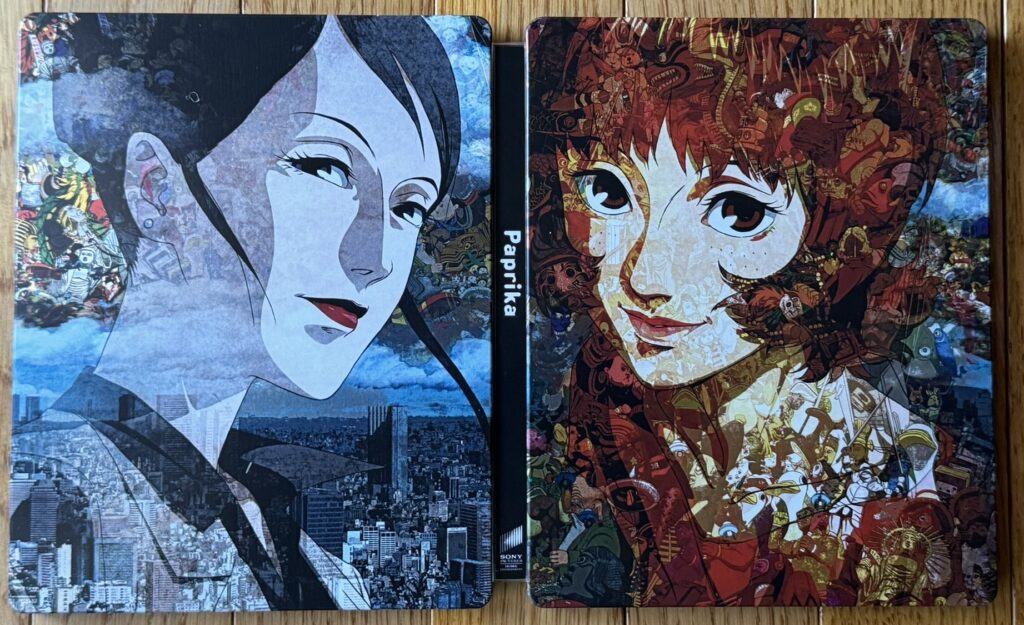
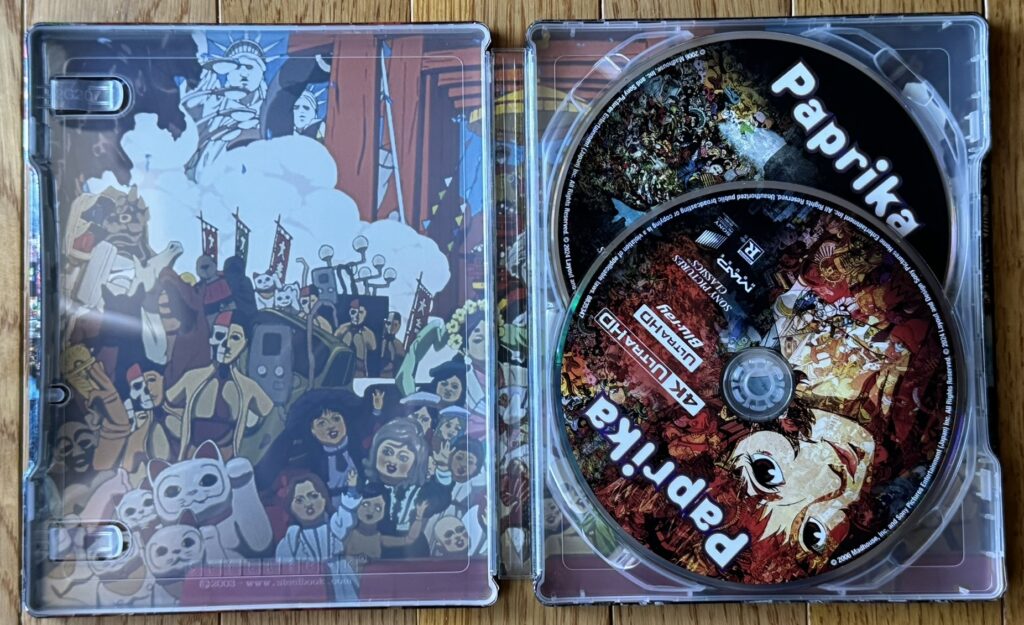
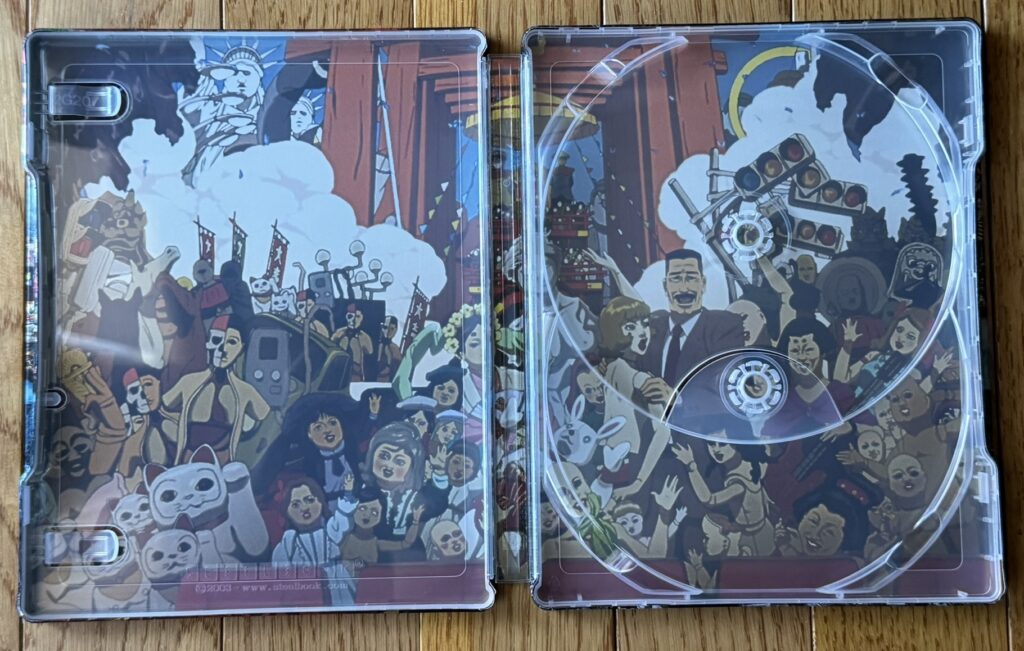
What’s Included:
- 2160p / Widescreen 1.85:1
- Dolby Vision / HDR10
- Audio: Japanese Dolby Atmos (Dolby TrueHD 7.1 compatible). Japanese 5.1 DTS-HD Master Audio, English 5.1 DTS-HD Master Audio, Cantonese 5.1, French 5.1 DTS-HD Master Audio, German 5.1 DTS-HD Master Audio, Italian 5.1, Spanish (Castilian) 5.1, Spanish (Latin American) 5.1, Thai 5.1
- Subtitles: English, English SDH, Arabic, Chinese Traditional, French, German, Italian, Korean, Spanish (Castilian), Spanish (Latin American), Thai, Turkish
- 1080p / Widescreen 1.85:1
- Audio: Japanese 5.1 DTS-HD Master Audio, English 5.1 DTS-HD Master Audio, Cantonese 5.1, French 5.1, German 5.1 DTS-HD Master Audio, Italian 5.1, Spanish (Castilian) 5.1, Spanish (Latin American) 5.1, Thai 5.1
- Subtitles: English, English SDH, Arabic, Chinese Traditional, French, German, Italian, Korean, Spanish (Castilian), Spanish (Latin American), Thai, Turkish
- 4K Digital Copy, redeemable via Movies Anywhere or Vudu
- Restoring Paprika* (8:26)
The filmmakers discuss the merits of shooting on film, how digital effects were used, maintaining the original look while also making it an HDR movie, the challenges of the parade scene, making use of elevated sound, and more. They discuss the process of converting the film, including upscaling using RSU (Reel Scale Plus), converting to HDR, and converting the sound to Dolby Atmos. Includes storyboard footage, clips, and interviews with HDR colorist Dai Kaneda, cinematographer/CG director Michiya Kato, color designer Satoshi Hashimoto, art director Nobutaka Ike, and re-recording mixer Shinichi Kita. Presented in Japanese with English subtitles. - Tsutsui and Kon’s Paprika (30:06)
This entertaining making-of documentary takes a look at Satoshi Kon’s three-year process of bringing Yasutaka Tsutsui’s novel to life as an anime film. The participants discuss the original novel, the challenges of adapting such a visually complex novel, how the two stories differ, the process of creating the script and storyboards, the voice recording process, the audience reactions, and more. Includes lots of behind-the-scenes footage, and interviews with author Yasutaka Tsutsui and director Satoshi Kon. Presented in Japanese with English subtitles, and in 4:3 format. - A Conversation About the “Dream” (29:03)
Author Yasutaka Tsutsui, director Satoshi Kon, and voice actors Megumi Hayashibara (“Atsuko/Paprika”) and Tôru Furuya (“Tokita”) sit down together to discuss the dream world of Paprika. The topics include their favorite scenes, the challenges of voicing the characters, their own dreams, and more. Presented in Japanese with English subtitles, and in 4:3 format. - The Art of Fantasy (12:08)
Art director Nobutaka Ike talks about giving the dream world and reality two distinct looks, making use of vivid colors like he hasn’t done in Kon’s previous films, augmenting drawings with digital effects, and more. Includes concept artwork and behind-the-scenes footage. Presented in Japanese with English subtitles, and in 4:3 format. - Filmmaker Commentary (1:30:50)
Director Satoshi Kon, composer Susumu Hirasawa, and associate producer Morishima provide an interesting and informative discussion of the film while also sharing some behind-the-scenes stories about the production. Presented in Japanese with English subtitles. - The Dream CG World (15:09)
Director of photography Michiya Kato talks about how CGI is used in the film to bring the dream world to life, while still keeping things looking hand-drawn. Some of the sequences he discusses are the rippling carpet in the hotel hallway, the confetti in the parade scene, driving through the pouring rain, lighting in various scenes, and more. Includes concept artwork, test animations, comparisons, and behind-the-scenes footage. Presented in Japanese with English subtitles, and in 4:3 format. - Storyboards Comparisons
Look at three scenes in various stages. First a side-by-side comparison of the storyboards and the finished final sequence, then the final scene next to both the original drawings and the character paintings, and finally full screen versions of the original drawings and the character paintings on their own. Select From:- The Parade Scene
- Storyboards Comparisons (:37)
- Original Drawings and Character Paintings (:33)
- Original Drawings (:30)
- Character Paintings (:35)
- The Ruins Scene
- Storyboards Comparisons (1:06)
- Original Drawings and Character Paintings (1:06)
- Original Drawings (1:03)
- Character Paintings (1:06)
- Skin Slitting Scene
- Storyboards Comparisons (:54)
- Original Drawings and Character Paintings (:54)
- Original Drawings (:51)
- Character Paintings (:54)
- The Parade Scene
- Domestic Trailer (1:23)
- International Trailer (1:46)
-
4K UHD:
Blu-ray:
Digital (Limited time offer):
Extras:
The new “Restoring Paprika” featurette can only be found on the 4K disc, while all legacy bonus material ported over from the 2007 release can only be found on the Blu-ray.
Final Thoughts:
I can’t say that I fully understood everything that was going on in Paprika, but it has a very interesting premise and some stunning visuals. The voice acting is terrific and offered in both the original Japanese language and an English dub. Sony’s newly-remastered 4K release looks and sounds great, and includes an interesting new featurette about the restoration as well as lots of fascinating legacy bonus material. The release also comes packed in a beautiful new SteelBook case. This is a must own for fans of the film, and a great way to check out the movie for new viewers.

